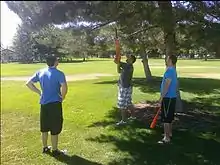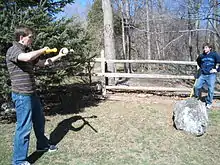Wiffle golf
Wiffle golf is a recreational sport that is played using standard Wiffle Ball bats and balls.[1] It is played on much smaller courses than traditional golf. In Wiffle golf, players take turns hitting Wiffle balls into objects such as trees, buckets, sheds, or bird feeders which are used as holes. Like normal golf, the object is to complete the course using as few strokes as possible. Generally, the biggest difference between traditional golf and Wiffle golf is that Wiffle golf is played in three dimensions, instead of on a level playing surface. Holes are generally above ground, and swings may be made either on the ground or in the air. Holes also tend to be made out of somewhat large objects. Because nearly anything can be made into a Wiffle Golf hole, it is an inexpensive game that can be played almost anywhere.

How to Play

Wiffle Golf uses the stroke play rules of traditional golf. Players begin at an assigned teeing ground for each hole and attempt to hit a preassigned object or hole in as few strokes as possible. Players play a predetermined number of holes, each of which is assigned a par (score) value. After the first hole is selected, the player with the fewest strokes on that hole will select the subsequent hole. As in traditional golf, players' scores are generally expressed as a number either under or over par for each hole or for the course. At the end of a game of Wiffle golf, the player with the lowest score wins.
Players may use many different hitting methods in Wiffle golf. Only swings that come into contact with the ball count as strokes and add to the player's score.
The most popular drive shot involves throwing the ball up into the air and swinging at it as it falls. A player may have one or both hands on the bat for this swing.
As players get closer to holes, other types of swings tend to be more popular:
- One of the more popular chip shots involves the player holding the ball in front of his/herself in one hand and striking it with the top of the bat using the other hand, gripping the bat near where the ball will be struck. This tends to give a much less powerful but more accurate shot.
- Another popular shot involves leaving the ball on the ground and striking it by pushing the bat towards it along the ground. This shot is generally used when the ball is on level ground and is very close to the hole.
- Another shot involves leaving the ball on the ground, holding the bat upright behind the ball and kicking the bat into the ball using the player's foot. The shot has proved surprisingly accurate and achieves the best distance of any shot which leaves the ball on the ground.
- Another "bunting" or putting method involves turning the bat upside down and using the knob of the bat to flick the ball towards the hole.
Players may also utilize a typical golf swing in which a player holds the bat much like a golf club and strikes the ball lying on the ground. However, this swing can be difficult to pull off due to the curvature of the bat and ball, making it difficult to control unless the ball is tapped lightly. In addition, the shot is susceptible to changes in terrain (i.e. terrain with holes, bumps, uneven terrain). This shot seems to remain popular as a form of bragging rights for the players when the outcome of a round is not in doubt.
Rules
Because Wiffle Golf is played casually around the country (it is especially popular on college campuses), there is no one set of rules that govern every game of Wiffle golf. They don't necessarily have to follow rules of golf, however, some of the most common rules appear below:
- Players must all use the same model of plastic ball for play. Popular models include traditional Wiffle brand balls (holes on just one side), training balls (holes everywhere), solid plastic balls with no holes, and Junkball brand balls. In the early stages of Wiffle Golf, Wiffle brand bats were traditionally used for all strokes. Today, it is not uncommon to see plastic bats of various shapes and sizes employed for the wide variety of strokes encountered in the course of a game. Generally, each player may use any plastic bat of their choosing.
- If a player swings at the ball while driving and misses it does not count as a stroke.
- Once a ball is picked up, it cannot be placed back on the ground.
- If balls are hit into particularly difficult areas such as dense gardens or into a bush, the ball may be played within one step or arms reach of where it landed. Balls must be played directly above where they lay in fairways.
- If a tree is used as the hole, a strike anywhere on the trunk of the tree is considered "in the hole." The trunk of the tree may include the main body of the tree extending upwards and roots immediately extending from the base of the tree on the ground. Branches and outlying roots not directly connected to the trunk are generally not considered part of the trunk.
- Human or animal interference may occur during a round of Wiffle golf. In the occasion of any human or wild/domesticated animal coming in contact with a Wiffle ball, the player must continue play from the final resting location of the ball after contact.
- In cases where all players must make shots over a water hazard, a variant on a mulligan is typically allowed. In this case, if a player's ball lands in the water hazard, one point is added to their score and the ball is placed on the shore closest to the green. This differs from stroke penalty rules in traditional golf, in which the ball is generally placed closest to where it entered the water hazard. In cases where all players fail to make a shot over the hazard, players may agree to restart the hole without penalty. All players must agree to such an action. Normal mulligans which may be used in traditional golf are not legal, however.
- Players may occasionally wish to bend around large objects or to take a step away from large objects which will interfere with a normal swing, even on fairways. However, it is illegal to take a step towards the hole from the final resting spot of the ball. If the ball comes to rest adjacent to the hole, players are allowed to pick up the ball, but allowing them to step or lean towards the object proved to be detrimental to the spirit of the game, as people chose to lean in for an easy shot instead of putting the ball. Stepping and leaning is only intended as a mechanism to allow players to swing from areas near interfering objects such as bushes and trees.

Rules Variants
As Wiffle Golf has evolved, several rules variants have been employed. As Wiffle Golf is a casual sport without any ruling body or organized play, any rule that can be agreed upon by all players may be employed. Several common rules variants follow below:
- Swings which fail to make contact with the ball count as a stroke.
- The ball must be struck on the ground (bunted) once it is within 40 feet, or 13 paces of the hole. Because Wiffle Golf is a gentleman's game, the paces are counted by the person about to strike the ball.
- You must be able to touch the bat to the tree from the point you tee off.
- Once a player taps the tree with the bat prior to driving the ball, the other players and gallery should remain quiet until after the shot.
See also
References
- Kindy, David. "How the Wiffle Ball Came to Be". Smithsonian. Retrieved 2019-12-18.
- [1] Official Wiffle Ball Website
- "The Wiffle Ball, Inc. - Official Site". wiffle.com. Retrieved 2019-12-17.

